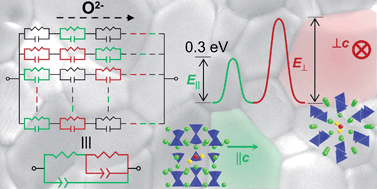Oxide ion conduction anisotropy deconvoluted in polycrystalline apatite-type lanthanum silicates†
Abstract
Recent efforts to understand the anisotropic

* Corresponding authors
a
School of Materials Science and Engineering, Chonnam National University, Gwangju, Korea
E-mail:
jongsook@jnu.ac.kr
Fax: +82 62 530 1699
Tel: +82 62 530 1701
Recent efforts to understand the anisotropic

 Please wait while we load your content...
Something went wrong. Try again?
Please wait while we load your content...
Something went wrong. Try again?
Y. Kim, D. Shin, E. Shin, H. Seo and J. Lee, J. Mater. Chem., 2011, 21, 2940 DOI: 10.1039/C0JM03242E
To request permission to reproduce material from this article, please go to the Copyright Clearance Center request page.
If you are an author contributing to an RSC publication, you do not need to request permission provided correct acknowledgement is given.
If you are the author of this article, you do not need to request permission to reproduce figures and diagrams provided correct acknowledgement is given. If you want to reproduce the whole article in a third-party publication (excluding your thesis/dissertation for which permission is not required) please go to the Copyright Clearance Center request page.
Read more about how to correctly acknowledge RSC content.
 Fetching data from CrossRef.
Fetching data from CrossRef.
This may take some time to load.
Loading related content
